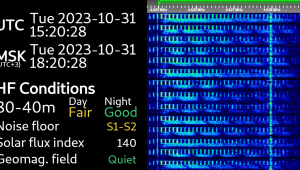The Next Big TV Thing

TV manufacturing is a tough business. You’re making a perfectly good black-and-white TV and then someone comes along with a color TV. So you need to make color TVs. Then TVs become digital. Then they become high-def. Then they become flat. Then they become big. Then they become 3D. Then they become really big. Then they become 4K. It just never ends.
TV makers are worried that people will stop buying TVs and instead just watch content on their smartphones and tablets. To avoid this latest threat of imminent doom, TV manufacturers are making their TVs smart. If the TV can do texting, people may still buy it. My response to the idea of smart TVs is simple: Don’t bother. Well, let me rephrase that. You should bother. But for their long-term health, TVs need more than intelligence.
Surveys show that while watching TV, about 75% (!)? of people are using another device. That’s usually a smart- phone or tablet, for messing around with social media. In the clearest possible terms, I would like to tell TV manufacturers that no matter how smart you make your TVs, it will never persuade people to stop messing with their phones.
Of course, TVs need to be smart. They need to let? you watch TV, surf, stream video, play online games, text, phone, Skype, etc. Of course, 3D is also good. But I doubt that will be enough. People still won’t camp out in front of stores to buy the newest TV. That’s because a smart?TV with a 90-inch screen is really just a giant smartphone that’s not as convenient or personal or cool as the iPhone or Android that’s in your pocket.
TV technology is evolving fast. Consider that a middle-aged TV engineer has in-depth knowledge of cathode-ray tube (CRT) design and/or analog-tuner design. Both of those skills, refined over decades, are now totally obsolete. If automobiles were evolving that fast, we’d be driving solar-powered flying cars. But even that pace isn’t fast enough because smartphones are evolving even faster.? To be competitive with phones, and to fend off Apple’s and Google’s own ambitions in the TV market, TV manufacturers need an entirely new technology. If a giant surfing LCD screen won’t cut it and 3D may not cut it, what will? A future TV needs to provide such a different entertainment experience from phones, and be so awesome to watch, that people will be willing to sit in their living rooms and put aside their phones. That’s a tall order for any TV designer. And what should that revolutionary new TV look like?
For starters, the next-gen TV needs to ditch the screen. After staring at small- and medium-size screens all day on our phones and tablets, a big screen is nice, but not really that awesome. To truly differentiate itself from a phone or tablet, the next-gen TV needs to obsolete the LCD panel as definitively as LCDs obsoleted the CRT. The next-gen TV needs to create a realistic and detailed image that places the scene in an x,y,z space and lets you walk around it and view it from different perspectives. I’m not talking about a 3D flat-panel; this would be some kind of higher-tech volumetric display — certainly not as advanced as the Holodeck on Star Trek: The Next Generation, but far more realistic than the projections in Star Wars.
Is it crazy to reference science fiction when imagining the next-gen TV? Probably. But if? TV manufacturers want to regain consumers’ eyeballs, that’s the kind of eye-popping technology they’ll need. I’m glad I’m not one of the TV engineers who gets the memo to design this. But as a consumer, I can’t wait to see what they come up with.
- Log in or register to post comments































































